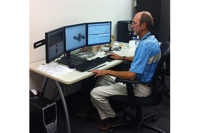Some of the largest machinery in the world depends on the smooth operation of tiny ball and roller bearings. Knowing this, manufacturers do all they can to make sure that the bearings they purchase for their equipment are completely free of defects.
One proven way to achieve this goal is to inspect each bearing with a state-of-the-art vision system. Chromasens GmbH designs and produces components for such systems, especially when the application requires stringent part-inspection tolerances.
Grand Rapids, MI-based integrator Active Inspection (AI) recently customized its aiUltimate Max 3D inspection system for a bearing manufacturer by incorporating two Chromasens 3DPIXA stereo line scan cameras and a Corona II LED line scan light. The products’ advanced capabilities enable the system to detect defects down to 3 microns on any type of ball, roller and sleeve bearing.
“Only a tailor-made inspection system could meet the requirements of this particular bearing manufacturer,” says Arun Dalmia, managing director of Active Inspection. “[The system needs to inspect for] all potential defects on both sides of a large variety of bearings at a rate of up to 80 parts per minute. Other defects included missing balls, rollers, needles and pins; incomplete imprints; scratches; and flatness control. Press defects were of particular concern as well.”
The latter type of defect occurs when individual bearing components are pressed together. As a result, the defect has small width and height extensions, and is flat with a shallow depth (only 100 microns). Detecting this defect requires precise 3D data, according to Dalmia.
AI engineers selected the Chromasens camera because it can simultaneously capture this data and 2D color images in real time. The images are taken at a speed of up to 29 kilohertz, with high resolution both laterally (15 microns) and vertically (5 microns).
To record 3D data, each camera relies on right and left internal RGB lenses that simultaneously capture dimensional data of the bearing as it is illuminated from above by a Corona II LED light. A dual-level conveyor belt and a Siemens PLC enable the cameras to take 3D images of the bearing top and bottom.
The PLC activates the inspection system when a bearing is conveyed under the first camera station on the top-level belt. After a photo is taken of the topside of the bearing, it is moved to the second camera station on a parallel lower belt and rotated 180 degrees. The bearing underside is then photographed and both results are sent to the PLC, which automatically verifies bearing quality before rejecting bad ones and transferring defect-free ones to the next processing step.
A high-end graphics card stores all 3D data from the stereo images. All 2D images are stored in the system’s database, from which the PLC forwards the results to the system’s control mechanism.
According to Dalmia, the bearing manufacturer regularly inspects more than 100 types of bearings, and typically inspects the same type of bearing one batch at a time. To ensure accuracy, the system is set up so that the operator must call up a specific test algorithm to inspect each type of bearing.
A built-in interactive editor lets the operator quickly create new test algorithms as needed, says Dalmia. After the person enters algorithm parameters based on the stored images of sample parts, the editor performs a calculation and displays the algorithm result on the system’s HMI display.
For more info on 3D stereo line scan cameras, call 949-699-6600 or visit www.chromasens.com.





